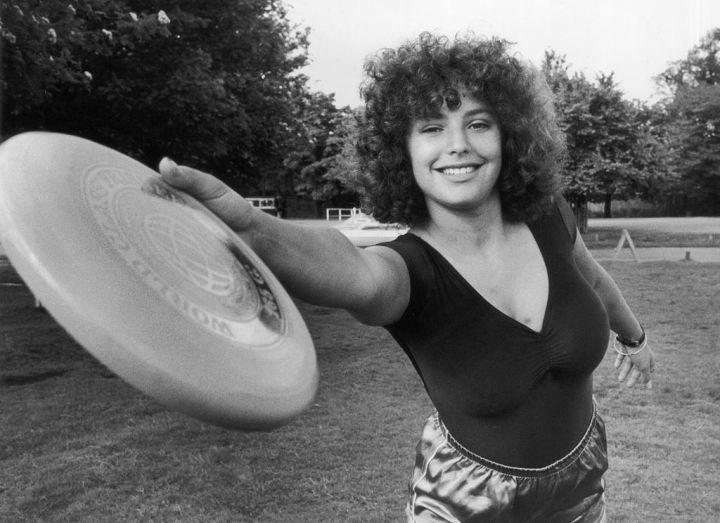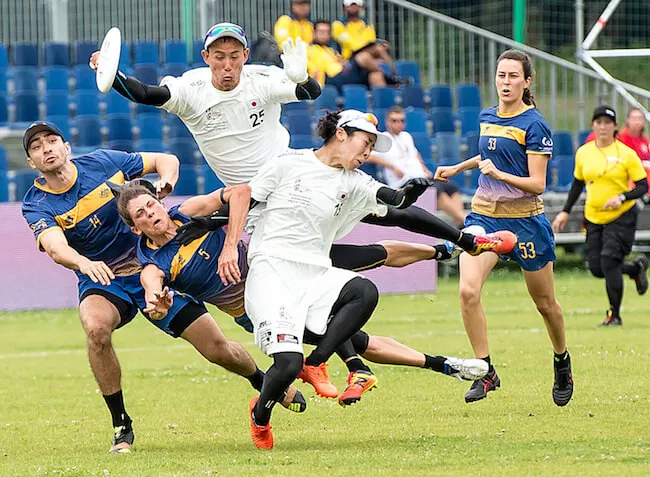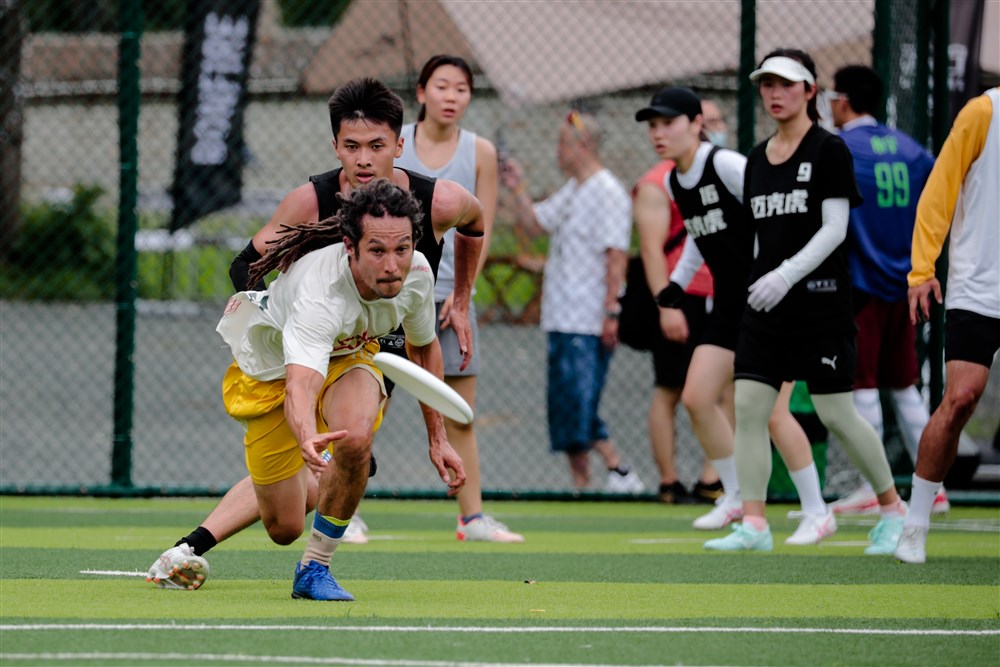ULTIMATE EVOLUTION
Ever increasing circles — yep, frisbee is indeed a sport

Despite the wonderfully wacky origins of Ultimate frisbee, the athleticism and gender equity of this unique sport have seen it gain global popularity.
For you, a frisbee might just be a low-effort way to play fetch with your dog or a silly way of having fun with your mates at the beach. If you ask a lot of people what it means to “play” frisbee, they’ll describe a game of catch with a cheap plastic disc instead of a ball, but for an increasing community around the world, frisbee has become a competitive sport.
If you’ve never heard of Ultimate frisbee, you could be forgiven for picturing a ridiculous outdoor gimmick along the lines of real-world Quidditch — even those who have heard of it may not be aware of how far it’s come since its quirky origins in the 1960s. Ultimate is being introduced in schools; actively practiced on a competitive level in more than 80 countries and has a contingent of advocates pushing for it as an Olympic sport.

New Zealand Ultimate frisbee player Zev Fishman dives for a frisbee during a photoshoot on 1 October, 2015 in Auckland, New Zealand. The International Olympic Committee have fully recognized the World Flying Disc Federation, ultimate frisbees governing body, meaning it is eligible for IOC funding and can compete with other sports for inclusion in future Olympic games. (Photo: Hannah Peters/Getty Images)

National teams of Japan (white) and Australia during a Frisbee game during the World Games of the non-Olympic sports in Wroclaw. (Photo: EPA / Maciej Kulczynski)
The invention of frisbees
Let’s start with the basics — a frisbee is a gliding disc with a pronounced lip, typically made from injection-moulded plastic. There are several variants of frisbees used in different sports, and similar soaring objects like the Aerobie (flying ring) that are also stabilised by gyroscopic force when spun, and frisbee or disc has colloquially become an umbrella term for all these objects.
The story of frisbees starts in 1871, when a man named William Frisbie opened the Frisbie Pie Company in Bridgeport, Connecticut. The pies came in disc-shaped tins that students from the nearby Yale University realised could glide when thrown. One day in the late 1930s, a wacky chap named Walter Frederick Morrison and his partner Warren Franscioni were offered 25 cents for a cake lid they were throwing around at the beach which had only cost them five cents, and Morrison realised there was money to be made from all this flying disc business.

The British frisbee team, United Kingdom, 22 August 1974. (Photo: Evening Standard/Hulton Archive/Getty Images)
Morrison’s business ideas were put on hold during World War 2, but after returning from the Army Air Force, he designed an aerodynamically improved flying disc he called the Whirlo-Way. Morrison and Franscioni began producing and selling Whirlo-Ways in 1948, and promptly renamed the product the Flyin’ Saucer after a string of reported unidentified flying object sightings. As their popularity soared, the discs went through several more official name changes, and eventually settled on frisbee after producers realised that college students were still calling them that after the pie lids that had been thrown around on campus.
The origins of Ultimate frisbee
People were playing versions of ultimate frisbee before the frisbee itself was even invented. There are accounts of people playing Tin Lid Golf, (an early incarnation of Disc Golf) which is still played today with a slightly smaller, denser disc) as far back as 1926 in Canada, and other games like Frisbee Football were played recreationally at parks and beaches across the US from soon after the frisbee’s mass production in the ‘50s, but Ultimate, the most popular disc sport, started with some dorky college kids in the late ‘60s.
According to Jared Kass, Ultimate evolved from a game of touch football at Amherst College where he was studying in 1966. A year later he taught it to his friend Joel Silver, and a year after that, Silver introduced Ultimate frisbee to the Columbia High School student council in Maplewood New Jersey. There’s a little disagreement about who is the real father of Ultimate — Kass came up with the basic rules and Silver formalised them and introduced the sport to the school system, where it took off.
The name “Ultimate” is thought to have come from Silver’s rather confident assertion that his new game was the “ultimate sporting experience”. Technically, the sport should be referred to simply as “Ultimate” rather than “Ultimate Frisbee” as the word Frisbee is trademarked by Wham-O Toys Incorporated, but in practice, it gets called that a lot anyway. They couldn’t stop us from calling it frisbee before they trademarked it, and they still can’t stop us from calling it that now.

Players battle for a frisbee during a match of the first Frisbee pre-season CUDL (Chinese Ultimate Disc League) on a football field in Beijing, China, 9 July, 2022. (Photo: EPA-EFE/Wu Hao)
The rules and ethos of Ultimate
The rules of ultimate combine aspects of various other sports. It’s similar to netball in that a player may not move with the frisbee, rugby/American football in that players score in an end zone, and soccer or hockey in terms of the strategy and the way that players move into space. Ultimate is popular as a casual sport — the rules are chopped and changed liberally at social games, but there are standardised rules for competitive games:
Each team has seven players, with a gender ratio of four to three that swaps throughout the game. A regulation field is 37 metres wide and 100 metres long, with 18 of those metres on either end being end zones. The objective of the game is to pass the frisbee up the field without losing possession until a player from your team successfully catches the frisbee in the opposing team’s end zone. Dropping the frisbee, an interception by the other team, or catching the frisbee out of bounds results in a turnover. Games are typically played to 15 points.
One of the most unique aspects of Ultimate is that it’s self-officiated — there’s no referee. The sport was born at the height of American counterculture, and its rules and ethos reflect the progressive, inclusive, hippy-dippy sensibility of the ‘60s (in its early days, the ultimate community even referred to themselves as the Frisbee Family). It operates on a set of heart-warming guidelines known as Spirit of the Game (SOTG) that discourage ‘win at all costs’ behaviour. For example, if a player fouls another accidentally, they are expected to call it themselves. Instances of players acting dishonestly are extremely frowned upon within the community.
As a result of SOTG and the balance of men and women on the field, ultimate is an easy sport to jump into for newcomers and people who have been less inclined towards team sports. Arguably, it teaches sportsmanship to kids better than any other sport, because playing fairly is even more important than playing skilfully, and SOTG makes it almost impossible to get away with bullying.
Ultimate at a competitive level
Social games and casual pick-up games will always be a large part of Ultimate, but its popularity has led to the forming of several professional leagues and international competitions. The American Ultimate Disc League (AUDL) includes 24 teams across the US and Premier Ultimate League (PUL) is a women’s professional league. The World Flying Disc Federation (WFDF) is the international governing body for the sport that oversees several global competitions, including the World Ultimate Club Championships and the World Ultimate and Guts Championships. In recent years, the WFDF has been pushing to include Ultimate among the sports competed in the Olympics, although it was recently announced that it would not be considered for 2028 in Los Angeles.
Ultimate has come a long way since the days of New Jersey high schoolers. Its uniquely flexible, athletic gameplay, SOTG, and gender equity have seen the standards and popularity of the sport steadily rise. There’s almost certainly a club, league, or pickup game within your reach — it’s worth a try if nothing else but to satisfy your curiosity for a weird and wonderful sport. DM/ML

















 Become an Insider
Become an Insider
South Africa has an amazing and varied Ultimate landscape; I am surprised that this article does not reference any of the local activities and leagues, or get commentary from SAFDA or its kin. Let’s tell more people about ultimate!
Ultimate is a brilliant sport and very welcoming. There is a very active community in Cape Town. More info for Cape Town based readers can be found here on the website for the Cape Town Flying Disc Association. DM does not allow links so just google “Cape Town Ultimate”.
It is a wonderful sport, and deceptively tiring to play. I would rate it as tiring as squash. Masters for men is 33 years old. ’nuff said.